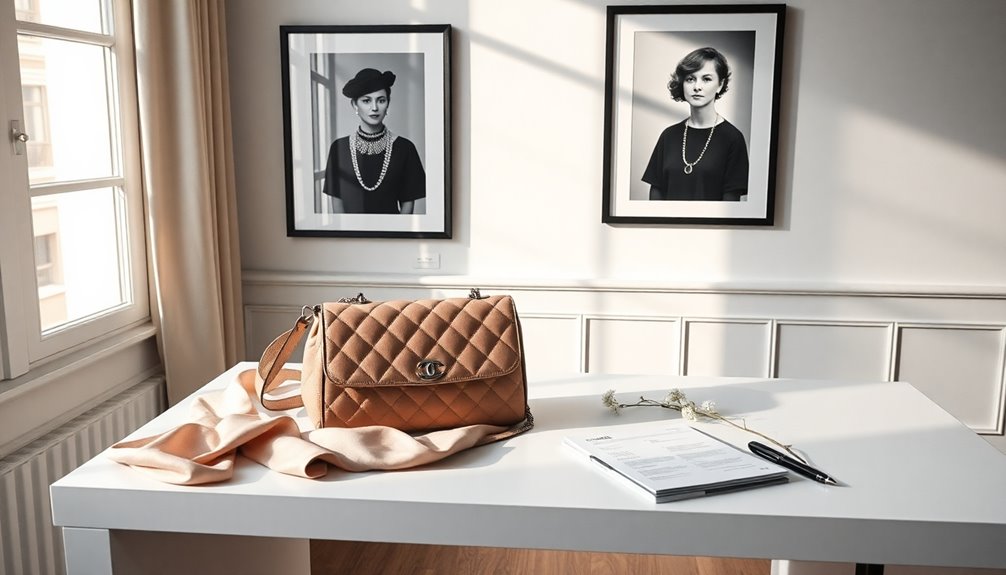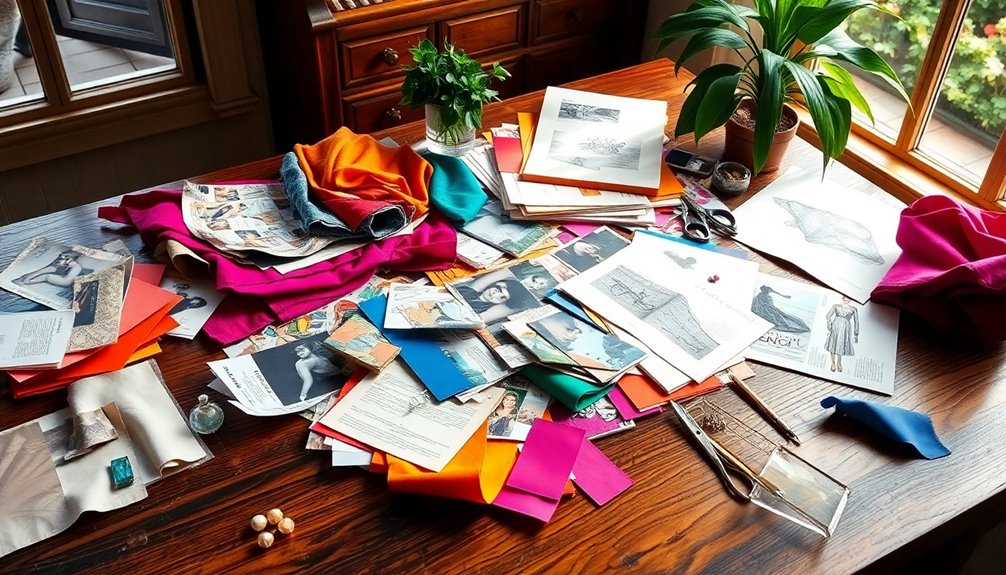Loewe, founded in 1846 by skilled leather artisans in Madrid, has made a significant mark in the luxury fashion world. You can trace its evolution from crafting elegant leather goods to becoming a global name. With influential creative directors like Jonathan Anderson, it's embraced innovation while honoring its heritage. The brand gained royal patronage early on, attracting celebrities and modern stars alike. After joining LVMH in 1996, Loewe expanded its reach to over 170 stores globally. Each step in its journey reveals a blend of tradition and modern flair, so you might find more intriguing insights about its impactful history.
Key Takeaways
- Founded in 1846 in Madrid, Loewe is renowned for its high-quality leather goods and royal craftsmanship.
- The brand expanded internationally in the 1960s, opening stores across Europe and Asia, reaching over 50 countries.
- Creative directors like Jonathan Anderson have modernized Loewe, enhancing its appeal and achieving significant social media visibility.
- Acquired by LVMH in 1996, Loewe became the oldest luxury house in the group, focusing on innovative and sustainable practices.
- The brand has maintained royal patronage and celebrity collaborations, reinforcing its status as a contemporary luxury leader.
Founding and Early Years
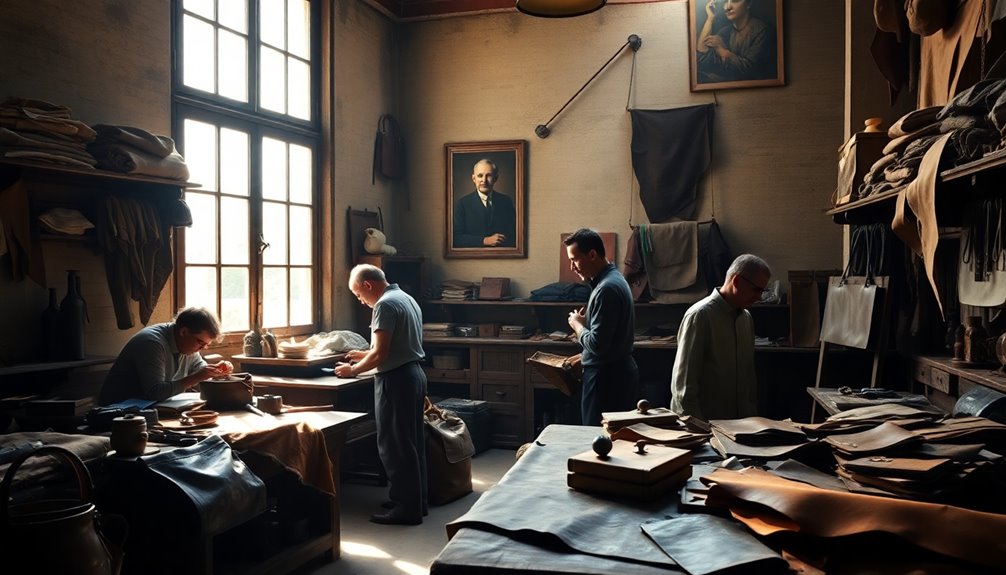
Loewe, a name synonymous with luxury, began its journey in 1846 when a group of Spanish leather craftsmen came together in Madrid. Initially, they specialized in crafting high-quality leather goods, producing items like purses, wallets, and jewelry cases. Situated on calle Lobo, this collective laid the groundwork for what would become a prestigious brand. In 1872, Enrique Loewe Roessberg, a German leather craftsman, joined the workshop and transformed its operations. His expertise in combining German precision with the spirited creativity of Spanish craftsmanship marked the brand's evolution. Under his guidance, the workshop adopted the name "E. Loewe," reflecting its growing identity. In 1905, Loewe received a Royal Warrant from King Alfonso XIII, solidifying its reputation for exceptional quality.
Expansion and Diversification
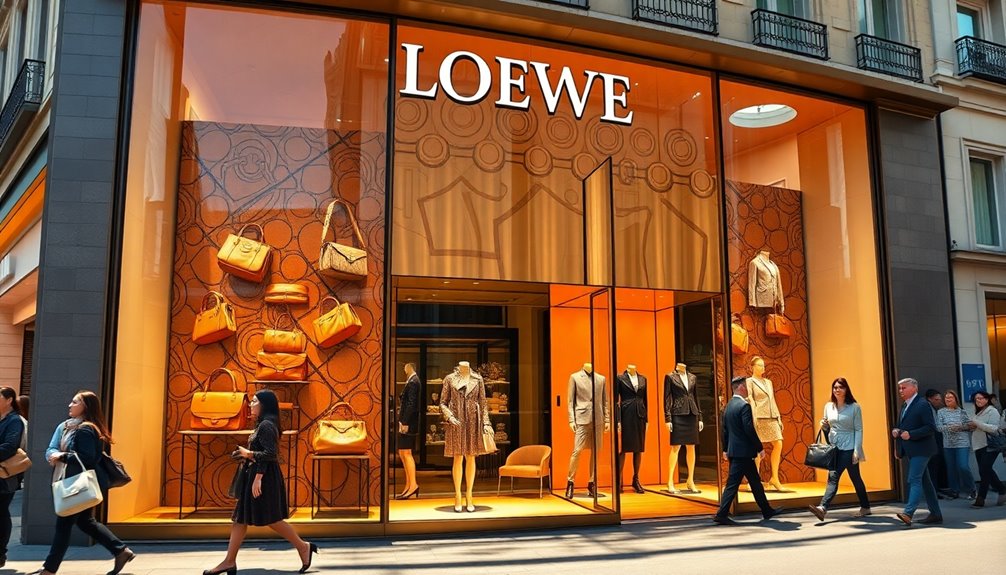
As the brand flourished, it ventured beyond Madrid, opening its first store on Príncipe de Madrid street and quickly earning the prestigious title of Supplier to the Royal Household from King Alfonso XIII. This accolade significantly boosted its reputation, leading to further expansion across Spain.
Loewe opened additional stores in cities like Barcelona, San Sebastian, and Bilbao, culminating in the inauguration of its flagship Gran Vía store in central Madrid in 1939, designed by Francisco Ferrer Bartolomé.
The 1960s marked Loewe's international ambitions, with stores opening in England and Japan. By the 1970s, the brand had established over 30 stores across Asia, including a significant presence in Tokyo, expanding its global reach to over 50 countries.
Alongside its geographical growth, Loewe diversified its product offerings. In 1965, it launched its first ready-to-wear collection and began designing women's handbags, which paved the way for further expansion into footwear, jewelry, and home products. This diversification was driven by the brand's focus on leather goods, which established its identity in the luxury market.
The introduction of fragrances in 1972 added another layer to its luxury portfolio, allowing Loewe to cater to a broader audience while solidifying its reputation as a leading luxury brand.
Creative Directors and Influences
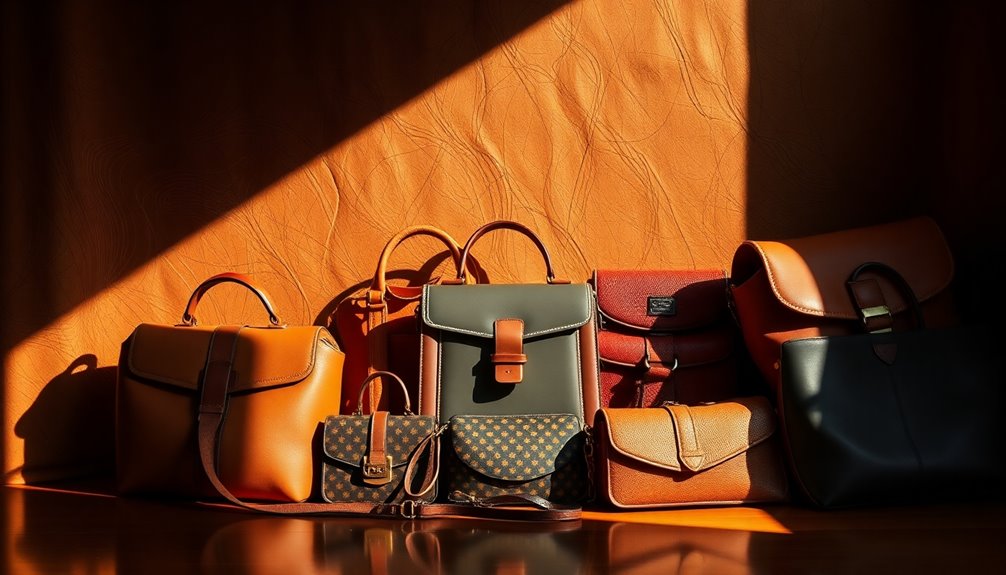
Throughout its history, Loewe has seen a succession of creative directors who've shaped its identity and direction.
Narciso Rodriguez, the first director post-LVMH acquisition, introduced a contemporary, minimalistic aesthetic that defined the 1990s. By modernizing the brand while honoring traditional craftsmanship, he laid the groundwork for Loewe's international expansion.
Following Rodriguez, José Enrique Oña Selfa built upon Loewe's heritage of leather craftsmanship. He infused contemporary elements into collections while maintaining the brand's luxurious image, ensuring a smooth transition from his predecessor's era.
Stuart Vevers took the helm next, emphasizing iconic leather goods and accessories. He sharpened the focus on ready-to-wear and introduced the “Tales of Spain” collection, appealing to a younger audience with modern designs that celebrated fluidity and femininity. Vevers’ modern designs also paid homage to the history of Bottega Veneta, incorporating the brand’s signature intrecciato woven leather into his collections. His bold vision revitalized the brand, attracting a new generation of fans while still honoring the rich history of Bottega Veneta. In doing so, Vevers solidified the brand’s reputation as a timeless and innovative powerhouse in the fashion industry.
Currently, Jonathan Anderson is transforming Loewe with his innovative vision. He launched the brand's first men's ready-to-wear line in 2015 and garnered accolades as both Womenswear and Menswear Designer of the Year. Under his direction, Loewe has gained significant attention in the fashion industry, achieving over 800 million views on TikTok, which has boosted its popularity among younger consumers.
With a new logo and artistic collaborations, Anderson continues to redefine Loewe, blending tradition with bold creativity. Each director has contributed significantly to Loewe's evolving narrative.
Royal and Celebrity Patronage

With deep roots in Spanish royalty and a legacy of celebrity patronage, Loewe has cultivated an image of luxury that resonates across generations. Founded in 1846, Loewe initially specialized in crafting exquisite leather goods for the Spanish royal family.
By 1905, King Alfonso XIII recognized the brand's craftsmanship, granting it the title of "Supplier to the Royal Court." This royal endorsement solidified Loewe's reputation and established strong ties with the monarchy, including Queen Sofía and Queen Letizia.
Loewe's allure has attracted numerous celebrities throughout its history. Icons like Ernest Hemingway, Sophia Loren, and Marlene Dietrich frequented the store, enhancing its prestige.
In contemporary times, Loewe's collaborations with stars like Beyoncé during her Renaissance World Tour showcase the brand's ongoing relevance and appeal. These high-profile partnerships not only bolster Loewe's modern image but also draw significant media attention. Loewe's commitment to innovation and craftsmanship has ensured that the brand remains a favorite among today's luxury consumers.
Acquisition and Global Expansion
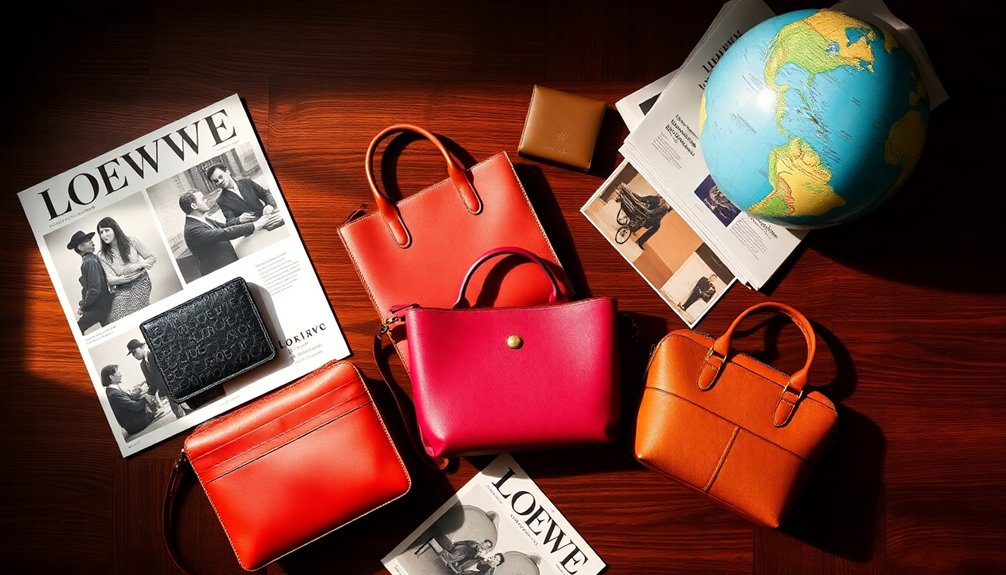
Loewe's rich heritage of royal and celebrity patronage laid a strong foundation for its growth, but the acquisition by LVMH in 1996 marked a transformative moment in the brand's journey.
This acquisition positioned Loewe as the oldest luxury fashion house within the LVMH group, sparking significant modernization and expansion efforts. With LVMH's robust resources, Loewe enhanced its international visibility and expanded its footprint, establishing flagship stores in key fashion capitals like Paris, London, and Tokyo.
You'll notice Loewe's careful approach to global expansion, targeting markets eager for luxury goods. Today, the brand operates in 35 countries with over 170 stores worldwide, particularly thriving in Asia with locations in Japan, Singapore, and China. Loewe has also focused on sustainable practices as it continues to expand its global reach, enhancing its appeal to environmentally-conscious consumers.
Strategic collaborations with local influencers have further fueled Loewe's appeal.
The appointment of Jonathan Anderson as Creative Director in 2013 played a pivotal role in this ascent. His avant-garde vision, blending traditional craftsmanship with contemporary aesthetics, captured global attention, leading to the introduction of the first men's ready-to-wear collection in 2014.
Under his leadership, Loewe has become a significant player in the luxury market, earning accolades like the "hottest brand of the year" in 2023.
Frequently Asked Questions
What Are Loewe's Key Sustainable Practices Today?
Loewe's key sustainable practices today focus on sourcing high-quality, low-impact materials, ensuring traceability and animal welfare.
They partner with environmentally conscious suppliers and conduct regular audits to uphold ethical standards.
You're likely to see their commitment to reducing CO2 emissions and waste through innovative packaging and recycling initiatives.
Plus, they emphasize transparency in supply chain management, aiming for a clear circular economy strategy that targets waste reduction and responsible resource usage.
How Does Loewe Combat Counterfeit Production?
To combat counterfeit production, Loewe implements several strategies.
You'll notice they hire experts and lawyers to tackle counterfeiting issues while tightening manufacturing processes.
Loewe invests millions annually in legal actions and collaborates with authorities to authenticate products.
They also educate customers on spotting fakes and ensure product quality through detailed inspections.
Where Can I Find Loewe Products Online?
You can find Loewe products online at their official website, www.loewe.com.
There, you'll discover a variety of collections, including bags, leather goods, and clothing. Simply add items to your shopping bag and proceed to a secure checkout.
You can pay using multiple methods, and prices are displayed in different currencies.
If you prefer, you can also opt for complimentary order collection from selected Loewe stores once your purchase is ready.
What Materials Are Commonly Used in Loewe Products?
You'll find a variety of high-quality materials in Loewe products. They often use calfskin and lambskin for their durability and softness.
Raffia, felt, and jacquard canvas add unique textures to their designs, while nylon elevates the luxury feel.
Loewe also emphasizes sustainability, incorporating recycled and upcycled fabrics, along with organic cotton.
Each material choice reflects their commitment to craftsmanship and innovation, ensuring you receive a product that's both stylish and environmentally conscious.
How Does Loewe Maintain Its Spanish Heritage?
Loewe maintains its Spanish heritage by embracing traditional craftsmanship and using local artisans for production.
You'll notice their designs often reflect Spanish culture, featuring vibrant colors and intricate patterns.
The brand also celebrates its history through the LOEWE FOUNDATION, which promotes artistic creativity and heritage.
Conclusion
Loewe's journey from its humble beginnings to a leading luxury brand is a testament to its resilience and innovation. You've seen how its creative directors have shaped its identity, while royal and celebrity endorsements have bolstered its prestige. As the brand continues to expand globally, it remains rooted in its rich heritage. Loewe's story isn't just about luxury; it's about a commitment to craftsmanship and creativity that resonates with you today. Embrace the allure of this timeless house.

